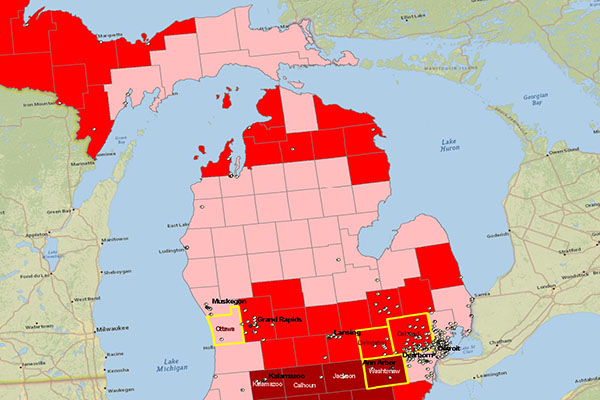Identify the Community
This section describes the type of information you will collect to learn about the community associated with your site, including their characteristics, demographics, and health concerns.
It is critical to identify all individuals, communities, and stakeholders (e.g., local businesses, state and local governments) who are potentially impacted by contamination at a site referred to as “the community” throughout this manual. Always be sure to first collect enough background information on the community (e.g., their needs and health concerns) such as from Internet searches and conversations with federal and state regulators before you reach out to the community. For more details on collecting this type of community information and how to engage with the community after you’ve done the necessary research, refer to the Engaging the Community section.
To get a sense of the site community, you can use various available resources that will help you identify the characteristics of the community surrounding your site.
Examples of the types of information health assessors can collect to get to know their site-specific community include:
- Community aspects, such as home statistics (whether residents rent versus own their homes).
- Special community considerations, such as non-English speakers.
- Circumstances that could make a population more vulnerable depending on the site-specific environmental contamination, such as living close to a landfill, consuming homegrown vegetables, or engaging in subsistence practices.
- Key values, such as strong family and community bonds.
- Key fears, such as fear of government, loss of property values, and safety concerns.
- Sources used by the community to get their information.
- Knowledge the community has of the site and site-specific issues.
- Other environmental issues, such as what other areas of contamination people are aware of.
Important: Health assessors need to collect information about the site community before making contact directly with community members. Gathering these data will make interactions with the community more meaningful and ensure you understand the community you will be working with.

Learn what common types of community information you need to collect from the Common Types of Demographic and Community Data Table and the Site Information Checklist [PDF – 853 KB].
Demographic information helps identify and define the size, characteristics (e.g., socioeconomic status), locations (distance and direction), and possible susceptibility of known populations (e.g., live in older homes that may have lead-based paint, reside close to a hazardous landfill) related to the site. When reviewing this type of information, keep in mind that demographic data can:
- Provide information on potentially exposed populations, which is important for determining site-specific exposure pathways, but alone do not define exposure.
- Be available from the national census, which is conducted once every 10 years. You might be able to find more recent population estimates between census years but will have to review their source and applicability carefully.
Health assessors can work with GRASP to help generate site-specific maps that they can use to better define exposure pathways. For example, imagine you have an on-site arsenic-contaminated stream that runs offsite into a neighborhood, resulting in the presence of arsenic-contaminated soils and sediments in many residential yards. If this was your site scenario, you would want to see if GRASP could help you define the area around the stream’s travel path to get a better estimate of the population potentially exposed to arsenic in the streambed.

GRASP can help health assessors use geographic information system (GIS) tools to gather valuable information about a community.
For many sites, having ATSDR’s GRASP generate a map depicting the demographic information for a specified geographic area (e.g., within a 1-mile radius around the site boundaries) will be very useful. The radius desired for your map will depend on site-specifics (e.g., if air dispersion of contaminants is the main issue, if surface water contamination is a concern and an area is particularly flat or sloped, or if there is a physical barrier like a highway that prevents access to the site by nearby populations).

Learn about common types of demographic data to collect.
Community Health Concerns
Understanding community health concerns related to a site or environmental release is an important component of the PHA process and ATSDR’s overall mission. It is critical to investigate community health concerns early in the process to the greatest extent practical and to choose the best PHA process product that will address community concerns.
There are many methods for identifying community concerns. You can collect information on community health concerns through site files, electronic searches, and social media (e.g., a community Facebook page). Speaking with other agencies involved with the site may provide key insights into community concerns. For more information on collecting health concerns and when to reach out to the community, refer to the Engaging the Community section in this e-manual.
When collecting community health concerns, focus on obtaining information related to potential site-specific impacts on people’s health or well-being. Keep in mind that the nature and degree of community concerns will vary from site to site. For example, at some sites, residents may have concerns about excess cancers in their neighborhood; at other sites residents may simply be looking for assurances that site-related contamination is not affecting them.

Learn more about common types of community concerns data to collect.
Health outcome data can provide information on the health of people living on or near a site. However, these data are routinely collected for some (e.g., cancer) but not all health outcomes, and health assessors only review health outcome data when certain criteria are met. ATSDR has specific criteria for health assessors to follow to determine when or when not to consider health outcome data.
Remember: Health outcome data will not prove cause and effect. Cause and effect may be addressed through certain types of epidemiologic studies that use specific criteria to examine possible causal associations (see the In-Depth Toxicological Effects Analysis section for more information).
If deemed appropriate for collection, these data might reveal whether people living or working near a site are experiencing harmful health effects at a rate higher than would be expected to occur. However, there has to be specific individual exposure information to truly link health outcomes with site-related exposures.
Health outcome data you may obtain include:
- Morbidity data (e.g., incidence of cancer, birth defects, or other diseases from state or county disease registries).
- Biological data (e.g., blood lead data from a state or county).
- Biomonitoring data collected by various parties documented in resources, such as the National Institute for Occupational Safety and Health (NIOSH) health hazard evaluations (HHEs) and university research publications.
- Mortality data (e.g., death certificates).
- Disease information from community health records, healthcare provider agencies, and individual entities (e.g., community health centers, private physicians).
- Health statistics from community health studies.
Consult with an ATSDR epidemiologist to determine the extent to which health outcome data will be useful for your site-specific evaluation.
The Community Concern Assessment Tool [PDF – 69.4 KB] can help assess the level of community concern.
The Community Data Worksheet [PDF – 64 KB] is a tool that can guide you to develop a basic understanding of the community before you even visit the site.